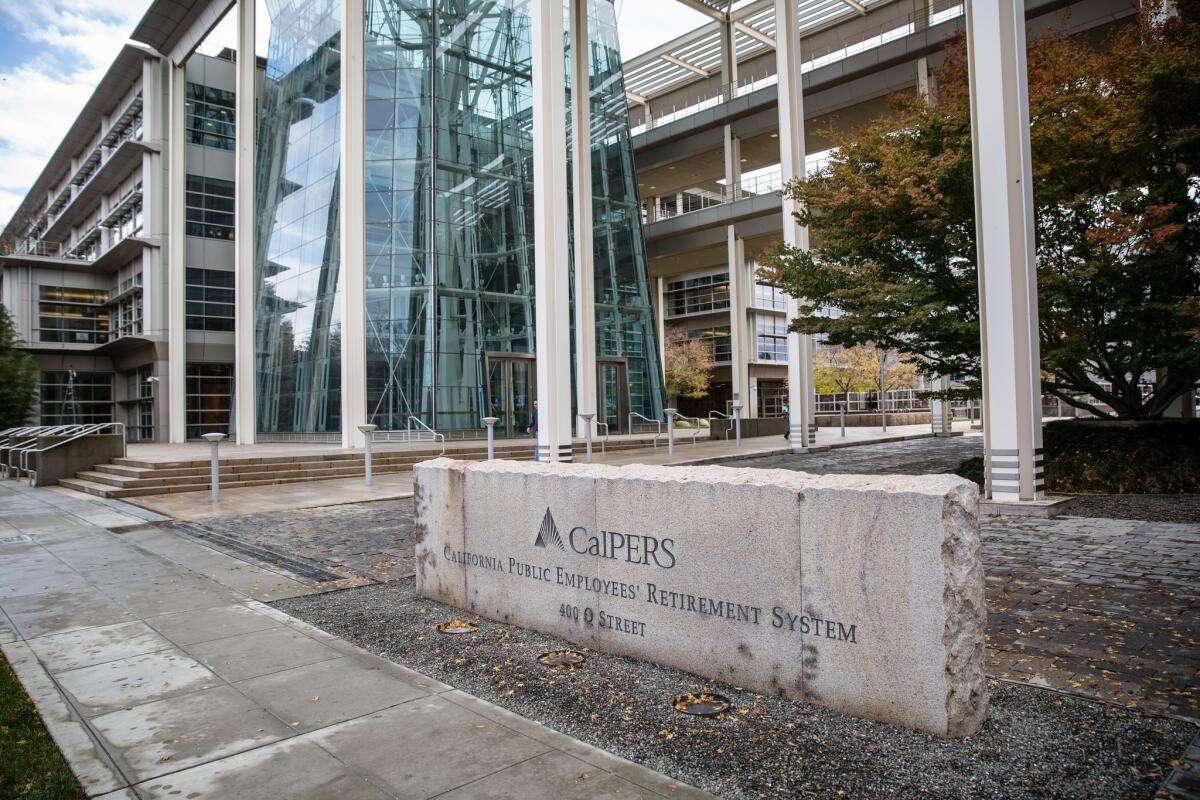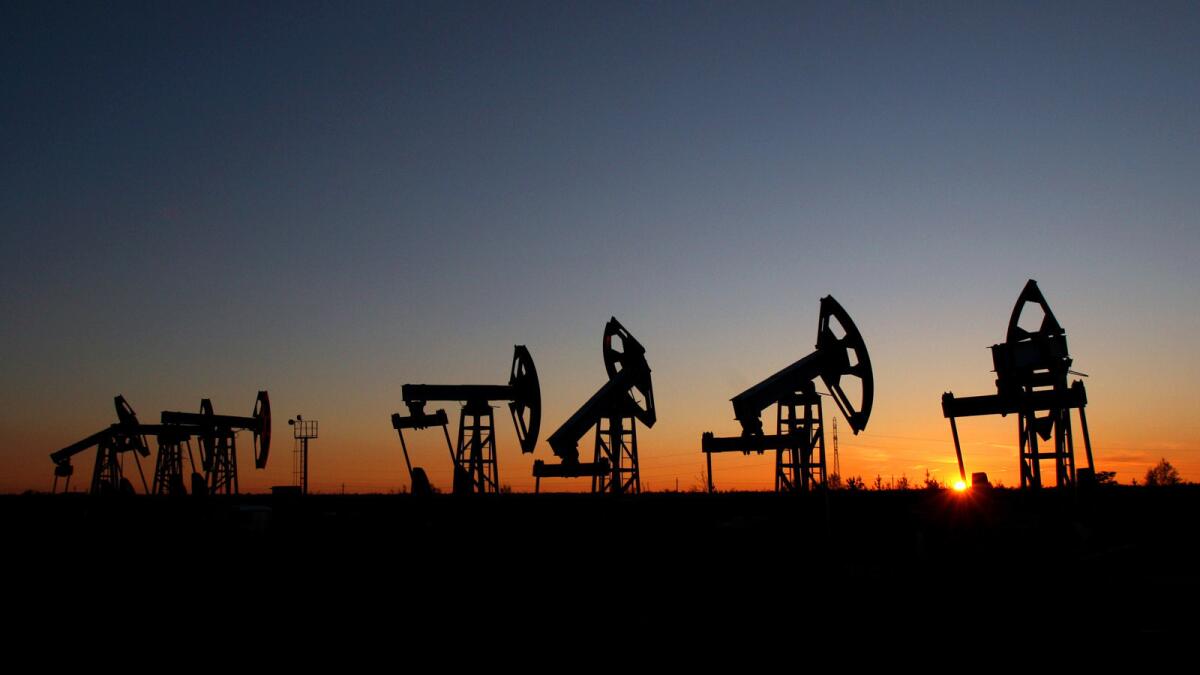Climate change threatens billions in CalPERS pension fund

California’s massive Public Employees’ Retirement System has released the first climate risk assessment of its $394-billion pension fund.
The draft report, which was submitted to the CalPERS board this month, found that one-fifth of the fund’s public market investments were in sectors that have high exposure to climate change. Those include energy, materials and buildings, transportation, and agriculture, food and forestry.
For the record:
9:12 a.m. Dec. 20, 2019A previous version of this story said California’s controller was Betty Lee. Her name is Betty Yee.
“It underscores what a big challenge we have on our hands,” said state Sen. Ben Allen (D-Santa Monica), who wrote the 2018 law that mandated the report. “There’s a lot of money at stake.”
The financial toll of climate change stems partly from its physical impacts, such as rising sea levels, fiercer storms and heat waves. However, companies’ bottom lines can also be affected by new regulations intended to curb warming, by lawsuits that seek to hold polluters accountable for climate damages, and by market trends, like the fast-dropping price of renewable energy.
Together, these factors create quite a puzzle for investors trying to maximize their returns.
“There’s no question that climate issues and warming are going to affect economies big time,” said Brad Barber, a finance professor at UC Davis. But “there’s still questions about how it’s going to impact various industries.”
Allen introduced Senate Bill 964 to make sure that CalPERS, which has a long history of climate activism, was fully considering such questions when it came to its own holdings.
“It’s ultimately smart portfolio management,” he said. “If we are not taking into account this stunning and catastrophic reality, we’re doing our funds a disservice.”
CalPERS is the largest public pension fund in the United States and manages retirement benefits for roughly 2 million state government employees.
SB 964 also requires California’s State Teachers’ Retirement System to produce a similar report for its $248-billion pension fund. That assessment is expected later this month, and both will be presented to the Legislature by Jan. 1. CalPERS and CalSTRS must then submit additional climate risk reports every three years until 2035. (Neither organization would comment on the assessments until they are finalized.)
Beyond identifying the 20% of investments in climate-exposed sectors, the CalPERS draft report did not go into great detail about the sources of climate risk to its portfolio.
At a board meeting this week, Anne Simpson, CalPERS’ investment director, said that was partly because the data they had to work with were “thin and frail.” Less than half of the 10,000-plus companies in their portfolio voluntarily disclose information about their carbon emissions, she said.

Nevertheless, the report concluded that utilities were the fund’s largest source of greenhouse gases. It said that was encouraging because utilities can choose where they get electricity and many are already transitioning to cleaner sources.
However, CalPERS board members and activists pointed out that the report omitted what are known as Scope 3 emissions — the indirect emissions associated with a company’s supply chain or the end use of their products.
For companies that sell coal, oil and gas, these emissions can make up 80% to 90% of their overall carbon footprint, said Nicole Pinko, a corporate analyst and engagement specialist at the Union of Concerned Scientists, which has pushed for a rigorous accounting of the sector’s climate risks.
By leaving out Scope 3 emissions, she said, the report underestimated the vulnerability of the fund’s fossil fuel holdings to future regulations like a carbon tax, or to market changes that could cause their assets to rapidly lose value.
“That would happen faster than the fund would be able to react,” said Steven Feit, an attorney at the Center for International Environmental Law, which backed SB 964. And it’s exactly “the kind of thing that pension funds should be protecting against,” he said.
When questioned by State Controller Betty Yee on Monday, CalPERS’ Beth Richtman disclosed that she did have estimates for Scope 3 emissions, but that they were not included in the draft report because the figures were considered unreliable and probably included duplicate emissions.
For instance, tailpipe emissions from cars would qualify as Scope 3 emissions for both automakers and oil producers, and would be counted twice if CalPERS held investments in both, said Richtman, the agency’s managing investments director for sustainable investments.
Richtman said that the Scope 3 emissions for CalPERS’ portfolio totaled 58 million to 68 million tons of carbon dioxide per year — about as much as the annual emissions from Finland.
That’s far greater than the 23 million to 24 million tons of CO2 per year that CalPERS estimated for the companies in its global equity portfolio based on what they emit directly and their electricity use. (Several board members encouraged Richtman and her staff to include the Scope 3 estimates in the revised report, even if they are uncertain.)
Some environmental activists also criticized the assessment for declining to quantify the potential financial impacts of climate lawsuits and for its failure to name the specific companies that presented the greatest climate-related risks.
“I’m here to express our profound disappointment,” Vanessa Warheit, the executive director of Fossil Free California, said at the public meeting Monday. She added that the report’s shortcomings made it “impossible to accurately assess where and how climate-related risk is distributed.”
Outside experts, on the other hand, praised the report as a good step toward making climate risk a central piece of CalPERS’ investment strategy, rather than a footnote.
“I think that’s one of the most positive signs, because that’s putting your money where your mouth is,” said Jesse Keenan, who studies climate-related financial risk at Harvard. “It will set a precedent for a lot of other investors.”
Keenan said he suspects that a much larger share of CalPERS’ portfolio is at risk from climate change, but it will take time to identify this exposure in industries that don’t regularly report on climate risk, such as apparel and aviation, and to extract it from those who manage some of the funds CalPERS invests in.
He said he expects to see more detailed information on individual holdings in an upcoming Asset Owner report, which CalPERS will compile according to new international guidelines for climate risk reporting. That report is expected to be released in 2020.
Critics complained that the report did not shed much light on how climate risk will actually shape CalPERS’ investment decisions going forward.
Environmental groups like Fossil Free California would like to see CalPERS divest completely from its fossil fuel holdings. (State law has already forced CalPERS and CalSTRS to divest from coal, and earlier this year the University of California announced it would rid its portfolio of all fossil fuel investments.)

The issue remains deeply divisive, and Pinko said the new report offers a strong defense of CalPERS’ current strategy of engaging with companies rather than walking away. For instance, their efforts helped prod Shell to include Scope 3 emissions in its greenhouse gas reduction goals, and to elicit better disclosure from many other companies.
“They do a really nice job of outlining some of the victories they’ve had, and why they feel that having a seat at the table might be a better option for them than divestment,” Pinko said.
But the report doesn’t address whether remaining invested in industries with climate risks is a good financial move for the fund — and some say it’s a difficult question to answer. “It’s still fast-evolving science, if you will,” Barber said.
While the physical impacts of climate change are clear, analysts don’t understand how they will affect specific regions, business sectors and companies well enough to advise investors about whether to steer clear. It may be premature to abandon corporations that might be able to adapt.
“Just because these industries are at risk doesn’t mean they that won’t be able to transform themselves into valuable enterprises,” Barber said.
Both CalPERS and CalSTRS will have to weigh these considerations as they work to align themselves with an executive order issued by Gov. Gavin Newsom in September directing them to put their funds toward investments that will decrease carbon emissions and increase climate resiliency. CalPERS has pledged to make its portfolio carbon-neutral by 2050.
It’s a particularly sensitive issue for CalPERS since many of its beneficiaries have spent their careers on the front lines of climate change, Pinko said. They include the firefighters who battle the state’s blazes and the civil servants who grapple with coastal flooding, poor air quality and the myriad other consequences of a warming world.
“These are their investments,” she said.







